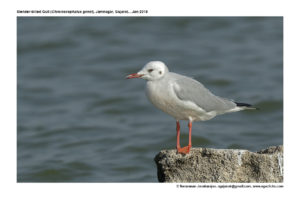Slender-billed Gull

Slender-billed Gull Chroicocephalus genei
Etymology:
- Chroicocephalus : Greek word khroizo– to colour, to stain; kephalos –headed
- Genei : Named after Italian naturalist Giuseppe Gené (1800–1847)
Vernacular Names: Pakistan: Kothar, Hindi: Kal-siri gangachilli, Guj: Gulabi dhomdo, Vadhomadi, Mar: Patal Chochicha Kurav
Distribution in India: Resident in coasts of Upper Gujarat and winter visitor in some parts of India.
Description:Size of 42-44cm; wt. of 220–350 g; wingspan of 94–110 cm. It has a distinctive shape, with long sloping forehead, long and slightly drooping bill, and long legs. While swimming it often holds the long neck tilted forward. The breeding adult has its head, neck, rump and tail white; back and upperwings grey; conspicuous white leading edge to wing, as outer 5 primaries mainly white, with black tips. The underparts are white, with rosy bloom on breast and belly in fresh plumage; bill and legs are dark red to blackish red, and iris is yellowish white with red eye-ring. The non-breeding bird is similar, but has a small dusky auricular spot. The immature differs from non-breeding adult in having dark flight-feathers, whiter primaries and dusky band on upperwing-coverts. The bill is bright red to pinkish orange, with small dark tip and the legs are pale orange or pinkish orange. The juvenile has buff-grey marks on head, including ear spot and vague partial hood. The immature differs from non-breeding adult in having dark flight-feathers, though primaries with much white, and dusky band on upperwing-coverts; bill is bright red to pinkish orange, with small dark tip; legs are pale orange or pinkish orange.
Habitat: It breeds at scattered coastal locations around the Mediterranean, Black and Caspian Seas and Persian Gulf, and at inland seas and steppe lakes in E Europe to C Asia. It nests colonially on islands, sand spits and beaches, or meadows, grassland, brackish or freshwater marshes of broad river deltas, occasionally in the marine littoral zone. In non-breeding season it can be seen on coastal areas, feeding in shallow inshore waters and especially at coastal wetlands and salt-pans.
Food habits: It eats small fish and aquatic invertebrates, captured at alkaline, saline or freshwater lakes or lagoons inland or along coasts. It engages in aerial dipping to surface, plunging from about 1 m, surface-dipping and upending. Small groups may fish cooperatively, driving fish into shallow water before capturing them by plunge-diving or by chasing them on foot. It also feeds in intertidal zone, probing in mud with bill. It performs Aerial foraging on swarming insects. It scavenges far less than most gulls.
Breeding habits: They breed in March to May in NW India, Pakistan and Mediterranean Sea. It selects open mud area for building nests. The nests are closely packed. They lay a clutch size of 2–3 eggs. The incubation period is 22 days. The adults recognize chicks by 4th day; chicks form crèches which adults lead towards sea. Creching provides some protection against predation. The fledging period is 30–37 days.